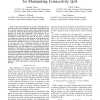344 search results - page 51 / 69 » Maximum Energy Welfare Routing in Wireless Sensor Networks |
EWSN
2004
Springer
14 years 7 months ago
2004
Springer
Directed diffusion is a prominent example of data-centric routing based on application layer data and purely local interactions. In its functioning it relies heavily on network-wid...
EWSN
2006
Springer
14 years 7 months ago
2006
Springer
Energy-aware algorithms have proven to be a crucial part of sensor network applications, especially if they are required to operate for extended periods of time. Among these, effic...
INFOCOM
2010
IEEE
13 years 6 months ago
2010
IEEE
Abstract— MaxWeight algorithm, a.k.a., back-pressure algorithm, has received much attention as a viable solution for dynamic link scheduling in multi-hop wireless networks. The b...
MDM
2010
Springer
13 years 9 months ago
2010
Springer
—Given the potential scale on which a Wireless Sensor Network (WSN) can be deployed, multi-hop communication will be a pivotal component of the system. When redundant nodes are d...
ESA
2006
Springer
13 years 11 months ago
2006
Springer
A sensor network consists of sensing devices which may exchange data through wireless communication. A particular feature of sensor networks is that they are highly energy constrai...

